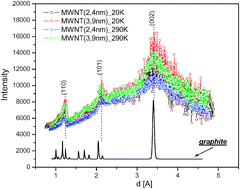Melting behavior of water in cylindrical pores: carbon nanotubes and silica glasses
Abstract
We report a study of the effects of confinement in

- This article is part of the themed collection: Water at interfaces
* Corresponding authors
a
Institute of Physics, Adam Mickiewicz University, Umultowska 85, Poznan, Poland
E-mail:
msb@amu.edu.pl
b
Department of Chemical and Biomolecular Engineering, North Carolina State University, 911 Partners’ Way, Raleigh, USA
E-mail:
keg@ncsu.edu
We report a study of the effects of confinement in

 Please wait while we load your content...
Something went wrong. Try again?
Please wait while we load your content...
Something went wrong. Try again?
M. Sliwinska-Bartkowiak, M. Jazdzewska, L. L. Huang and K. E. Gubbins, Phys. Chem. Chem. Phys., 2008, 10, 4909 DOI: 10.1039/B808246D
To request permission to reproduce material from this article, please go to the Copyright Clearance Center request page.
If you are an author contributing to an RSC publication, you do not need to request permission provided correct acknowledgement is given.
If you are the author of this article, you do not need to request permission to reproduce figures and diagrams provided correct acknowledgement is given. If you want to reproduce the whole article in a third-party publication (excluding your thesis/dissertation for which permission is not required) please go to the Copyright Clearance Center request page.
Read more about how to correctly acknowledge RSC content.
 Fetching data from CrossRef.
Fetching data from CrossRef.
This may take some time to load.
Loading related content
